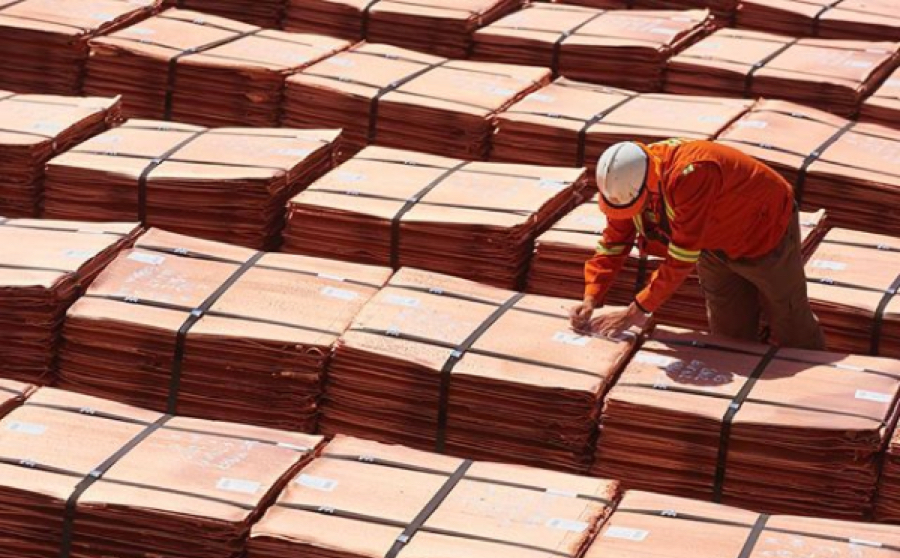LME copper squeeze will test market’s bull credentials

Is copper finally about to break up out of its well-trodden seven-month range?
London Metal Exchange (LME) three-month copper came tantalisingly close on Wednesday with a mini-surge to $6,426.50, challenging the upper band of the $5,725 to $6,440 range that has defined the market since July 2018.
The market was regrouping Thursday around the $6,380 level.
Glencore set the ball rolling with an announcement that an “updated mine plan” at its Mutanda copper operations in the Democratic Republic of Congo would reduce output by 100,000 tonnes per year.
Momentum came from chart dynamics, specifically a break of the 200-day moving average on Tuesday, and frantic covering by options traders against upside exposure.
Exchange stocks can often flatter to deceive
What really primed the move, however, was a dramatic tightening in LME time-spreads. The benchmark cash-to-three-months period flipped from small contango at Friday’s close to $58 backwardation at Monday’s close, the tightest the spread has been since October last year.
The contraction was sharp and brutal for short position-holders but not entirely unexpected.
Stocks of copper registered with the LME are super low. Indeed, global exchange stocks are low, which is why a growing number of copper bulls argue that copper’s robust micro dynamics can turn back the bear tide of macro negativity.
The return of time-spread tightness is going to put that argument to the test.
Shanghai stocks up, US stocks down
The total amount of copper registered with the world’s three exchanges — LME, Shanghai Futures Exchange and CME — rose by 60,300 tonnes in January and the first half of February.
Rising exchange inventory is normal at this time of the year, a seasonal low spot for manufacturing activity.
Not only has this year’s rise been highly modest so far, but at 411,000 tonnes total exchange inventory is 345,000 tonnes lower than it was at the same point of 2018.
Moreover, just about all of the increase to date has taken place in Shanghai, where stocks are up by 88,432 tonnes since the start of January.
This too is normal, seasonal demand weakness being overlaid by the Lunar New Year holidays.
The build in Shanghai has been significantly offset by a fall in CME stocks, down by 36,143 tonnes on the start of January with metal still flying daily out the warehouse door.
CME inventory, all of it located in the United States, has been dwindling steadily since May last year.
Some of the metal may well have migrated to LME warehouses thanks to the massive arbitrage gap that opened up between the two exchanges last year.
That gap has just snapped shut as a previously stranded mountain of metal in CME locations such as Salt Lake City and Tucson rapidly diminishes.
Arbitrage may have been behind the January deliveries into LME warehouses in New Orleans but since then LME stocks in the United States have also been falling with more scheduled to depart, judging by some sizeable cancellations of metal in Chicago and New Orleans.
Those cancellations have left LME “live” stocks at just 76,025 tonnes, not far off the decade-low of 57,650 tonnes registered at the end of October, the last occurrence of severe spread tightness.
Where’s the metal?
Exchange stocks can often flatter to deceive.
The copper market still remembers the zig-zag in LME stocks over the course of 2017, a repetitive loop of huge deliveries and equally huge departures as two trading houses slugged it out.
Should we believe stocks this time?
Yes, according to Citi, a prominent bull in the market with a call for a 10 percent rally over the next three to six months.
The bank says it was high trucking costs that isolated much of the CME stock. With those costs since abating but U.S. physical copper premiums remaining high, metal previously stranded in Arizona and Utah has been going to consumers. (“The US Copper stock shift and CME-LME arb”, Feb 19, 2019).
The lack of inflow at LME locations in the United States, just 475 tonnes so far this month, and bursts of cancellation activity in Chicago and New Orleans support such a view.
But exchange stocks are only ever the tip of a larger inventory pool.
Slack LME time-spreads over the last couple of months mean that metal availability hasn’t been tested.
This week’s action may be about to change that.
Spreads test
The ferocity of the return to backwardation on the LME seems to have been in part down to one of those large-position clashes that often enliven spread trading.
The LME’s positioning reports showed there were three significant longs as of the close of business Friday, each holding warrant and cash positions equivalent to 50 to 80 percent of stocks.
That’s not quite as sinister as it sounds, remembering that these positions are measured against the low LME open tonnage.
But the number and size of the longs clearly spooked short-position holders. The “tom-next” spread , the cost of borrowing metal for one day, spiked out to a $20 backwardation on Tuesday morning.
Things have calmed down a little since then. The number of dominant longs had fallen to two as of the close of business Tuesday and one of them has diminished in size.
“Tom-next” has seemingly normalised but the broader tightness hasn’t dissipated. Cash metal was still $20 per tonne higher than three-month metal as of Wednesday’s close.
It’s not as if LME time-spreads shouldn’t be tight, given that available tonnage is so low.
If anything, it was January’s contango structure that looked anomalous.
Borrowing the spreads may have been an enticing trade for those believing in copper’s robust micro dynamics but with less conviction on the macro landscape.
If so, there may well be more collisions of multiple dominant longs and short-position holders ahead. And backwardation may be here to stay for a while.
That will test how much copper is really “out there” and available for exchange delivery.
Not much, if bulls such as Citi are right.
Maybe quite a lot, if January’s relaxed spreads weren’t just an anomaly.
Another dilemma for Doctor Copper.
(By Andy Home; Editing by Edmund Blair)
{{ commodity.name }}
{{ post.title }}
{{ post.date }}

Comments